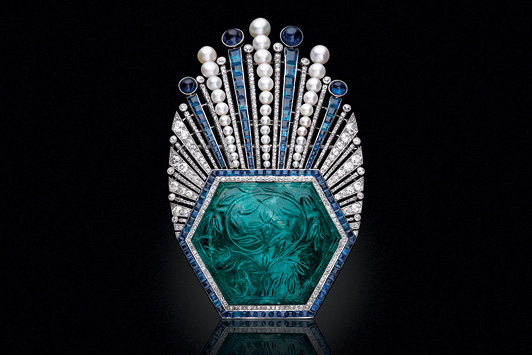
Like all rare art forms, gemstone carving has a rich history — beginning in ancient China, it came into its own during Mughal rule in South Asia, and its appeal continues today. Every season, the stories of carved gems are chronicled by auction houses, museums, high-jewelry brands and designers.
Common practice among modern lapidary artists is to utilize the lowest-quality gem material for carvings and beads; top-grade material is for faceting, and medium-grade is converted to cabochons. However, auctions of vintage jewelry from the Mughal and Art Deco periods — when Cartier, Van Cleef & Arpels and Mauboussin used excellent material for carvings — have revealed growing demand for high-quality specimens.
“The modern concept of employing carvings to hide inclusions emerged in the 1950s,” explains gem specialist Dharmendra Tank of Tank Fine Gems. “The last five years, however, have seen a refinement in taste, leading to a 30% increase in the demand for fine gem carvings.”
This rising interest in carvings — whether in gemstones or cameo art — stems from a desire for a distinctive piece that is, to a certain extent, irreplaceable. So says Amedeo Scognamiglio, creative director of cameo-focused brand Amedeo and the Faraone Mennella jewelry line.
“In a world where everything is so digitized, modern, tech-driven, the only thing that can engage consumer interest is something hand-crafted,” Scognamiglio says. “Our clients love being a part of the artisanal journey to create something personal, one-of-a-kind.”
His company, he continues, currently utilizes “turquoise, corals, shells for cameos, obsidian — hand-crafted in Italy, continuing the tradition that started in the late 17th century in the city of Trapani in south Italy. Our atelier employs traditional carving techniques but with a contemporary design twist, something like the rock ’n’ roll version of classical cameo art.”
Much like Scognamiglio, whose Italian heritage had a profound impact on his style, Sweta Jain from Goshwara remembers how her early years in India influenced her design sensibilities. “I grew up watching master carvers work their magic, giving each stone a distinct identity, which I always felt enhanced their beauty. While traditional motifs have influenced my aesthetic, I am inspired mostly by architecture, especially the more geometric shapes and patterns. They could be in everyday objects, buildings or historical monuments.”
Past meets present
History has always played an essential role in the field of gems and jewelry. In 2001, the Metropolitan Museum of Art (the Met) commissioned jewelry artist Munnu Kasliwal of Munnu: The Gem Palace to create a contemporary Mughal collection to coincide with an exhibition on India’s jeweled arts.
“Our experiments with material and design, amalgamating the historical with the contemporary, happened after this partnership with the Met,” recalls Kasliwal’s son Samarth, a partner in the business. “We started carving citrine, amethyst, rock crystal, peridot, aquamarine to create Mughal-inspired modern jewelry with gems in an open setting [and] 22-karat gold.”
Since then, he reports, the company has seen growth in this category among US and European clients. “While our current collections continue to build on the legacy of our father, we are inspired by the traditional architecture of Jaipur and modern geometric shapes and patterns,” he adds.
The measure of their worth
Do carved gemstones hold value over time? Marco Hadjibay, creative director of luxury jeweler Bayco, strongly believes they do.
“People have a misconception that carved gems are not valuable. They don’t realize [that] while it’s fairly easy to find carvings in commercial-grade material, finding an exceptionally carved emerald, sapphire or ruby that is untreated and of top-grade quality is quite rare,” he says. “We have a pair of facet-grade carved Zambian emeralds in our collection that we know are very difficult, if not impossible, to replicate. We employ only the finest carved material in our jewelry, and these are either sourced through estate sales or from Jaipur
in India.”
While the market for carved gems is comparatively niche, these stones tend to attract a discerning clientele with refined taste and a willingness to invest.
Image: Christie’s Images Ltd.Article from the Rapaport Magazine - November 2019. To subscribe click here.